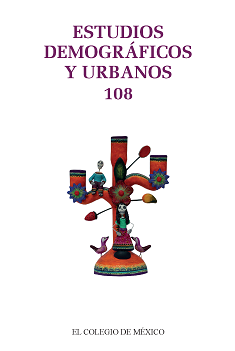La esfera familiar y la participación económica de las mujeres: una reflexión en torno a la tesis de las preferencias de Catherine Hakim
Publicado 2021-09-17
Palabras clave
- Catherine Hakim,
- teoría de las preferencias,
- familia,
- mercado de trabajo,
- políticas públicas
Cómo citar
-
Resumen2325
-
PDF (español)531
-
En línea (español)109
Descargas
Derechos de autor 2021 Estudios Demográficos y Urbanos

Esta obra está bajo una licencia internacional Creative Commons Atribución-NoComercial-SinDerivadas 4.0.
Métrica
Resumen
El objetivo del presente artículo consiste en sintetizar la teoría de las preferencias de Catherine Hakim, que desarrolla una perspectiva bastante original en las reflexiones que se centran en la dicotomía familia y mercado de trabajo en la población de las mujeres. Este análisis busca principalmente exponer, por un lado, las aportaciones de la propuesta de Hakim y sus limitaciones mediante las críticas que ha recibido en los debates sociológicos y demográficos. Por otro, se intenta esclarecer sus aplicaciones en cuanto a las políticas públicas orientadas al mejoramiento de las condiciones de las mujeres en las dos esferas.
Referencias
- Acosta, F. (2003). La familia en los estudios de población en América Latina: estado del conocimiento y necesidades de investigación. Papeles de Población, 9(37), 1-51. http://www.scielo.org.mx/scielo.php?script=sci_arttext&pid=S1405-74252003000300002
- Arriagada, I. (2001a). Familias latinoamericanas. Diagnóstico y políticas públicas en los inicios del nuevo siglo. (Documento de trabajo, núm. 57). Serie Políticas Sociales. Santiago de Chile: Comisión Económica para América Latina y el Caribe. https://repositorio.cepal.org/bitstream/handle/11362/6022/S01121052_es.pdf?sequence=1
- Arriagada, I. (2001b). Políticas sociales, familia y trabajo en la América Latina del fin de siglo. (Documento de trabajo, núm. 21). Serie Políticas Sociales. Santiago de Chile: https://repositorio.cepal.org/bitstream/handle/11362/6221/S9700708_es.pdf?sequence=1&isAllowed=y
- Becker, G. (1965). A theory of allocation of time. The Economic Journal, 75(299), 493-517. https://www.jstor.org/stable/2228949?seq=1#metadata_info_tab_contents DOI: https://doi.org/10.2307/2228949
- Becker, G. (1987). Tratado sobre la familia. Madrid: Alianza Universidad.
- Blossfeld, H. y Hakim, C. (1997). Between equalization and marginalization. Women working part-time in Europe and the United States of America. Oxford: Oxford University Press. DOI: https://doi.org/10.1093/oso/9780198280866.001.0001
- Castel, R. (1994). La dynamique des processus de marginalisation: de la vulnérabilité à la désaffiliation. Cahiers de Recherche Sociologique, 22, 11-27. https://www.erudit.org/en/journals/crs/1994-n22-crs1516985/1002206ar/ DOI: https://doi.org/10.7202/1002206ar
- Castel, R. (1995). Les métamorphoses de la question sociale. París, Francia: Fayard. DOI: https://doi.org/10.3406/agora.1995.1517
- Castel, R. (2009). La montée des incertitudes. Travail, protections et statut de l’individu. París, Francia: Seuil.
- Castel, R. (2010). El ascenso de las incertidumbres. Trabajo, protecciones, estatuto
- del individuo. Buenos Aires: Fondo de Cultura Económica.
- Cartwright, S. (2004). Women’s decisions about paid work and family life after childbirth: A Critique of the Hakim model. En S. Charlesworth y M. Fasteanu (eds.), Women and work (pp. 27-40). Australia: RMIT Publishing.
- Crompton, R. y Lyonette, C. (2005). The new gender essentialism-domestic and family choices and their relation to attitudes. The British Journal of Sociology, 56(4), 601-620. https://www.ncbi.nlm.nih.gov/pubmed/16309438 DOI: https://doi.org/10.1111/j.1468-4446.2005.00085.x
- Crompton, R. Brockmann, M. y Lyonette, C. (2005). Attitudes, women’s employment and domestic division and labor: A cross-national analysis in two waves. Work, Employment and Society, 19(2), 213-233. https://journals.sagepub.com/doi/10.1177/0950017005053168 DOI: https://doi.org/10.1177/0950017005053168
- Del Valle, E. (2009). El empleo a tiempo parcial como herramienta para compatibilizar la flexibilidad laboral y la conciliación de la vida personal y laboral. España: Consejo Económico y Social.
- De Oliveira, O. y Ariza, M. (1999). Trabajo, familia y condición femenina: una revisión de las principales perspectivas de análisis. Papeles de Población, 5(20), 89-127. https://www.redalyc.org/pdf/112/Resumenes/Resumen_11202005_1.pdf
- Doughney, J. y Leahy, M. (2006). Women, work and preference formation: A critique of Catherine Hakim’s preference theory. Journal of Business Systems, Governance and Ethics, 1(1), 37-48. https://jbsge.vu.edu.au/index.php/jbsge/article/view/79/130 DOI: https://doi.org/10.15209/jbsge.v1i1.79
- Duncan, S. (2006). Mothers’ work-life balance: Individualized preferences or cultural construction? En D. Perrons, C. Fagan, L. McDowell, K. Ray y K. Ward (eds.), Gender divisions and working time in the new economy (pp. 127-147) Cheltenham: Edward Elgar Publishing. DOI: https://doi.org/10.4337/9781845428976.00017
- Duncan, S. e Irwin, S. (2004). The social patterning of values and rationalities. Social Policy and Society, 3(4), 391-399. http://eprints.whiterose.ac.uk/1295/ DOI: https://doi.org/10.1017/S1474746404002076
- García, B. y De Oliveira, O. (1994). Trabajo femenino y vida familiar en México. Ciudad de México, El Colegio de México, A.C. DOI: https://doi.org/10.2307/j.ctvhn0971
- García, B. y De Oliveira, O. (2007). Trabajo extradoméstico y relaciones de género: una nueva mirada. En M. A. Gutiérrez (comp.), Género, familias y trabajo: rupturas y continuidades. Desafíos para la investigación política (pp. 49-87). Buenos Aires: Consejo Latinoamericano de Ciencias Sociales.
- García, B. y Rojas, O. (2002). Los hogares latinoamericanos durante la segunda mitad del siglo XX: una perspectiva sociodemográfica. Estudios Demográficos y Urbanos, 17(2), 261-288. https://estudiosdemograficosyurbanos.colmex.mx/index.php/edu/article/view/1139/1132 DOI: https://doi.org/10.24201/edu.v17i2.1139
- Gash, V. (2008). Preference or constraint? Part-time workers’ transitions in Denmark, France and the United Kingdom. Work Employment Society, 22(4), 655-674. https://journals.sagepub.com/doi/10.1177/0950017008096741 DOI: https://doi.org/10.1177/0950017008096741
- Ginn, J., Arber, S., Brannen, J., Dale, A., Dex, S., Elias, P., Moss, P., Pahl, J., Roberts, C. y Rubery, J. (1996). Feminist fallacies: A reply to Hakim on women’s employment. The British Journal of Sociology, 47(1), 167-174. https://www.ncbi.nlm.nih.gov/pubmed/8680791 DOI: https://doi.org/10.2307/591122
- González de la Rocha, M. (coord.) (1999). Divergencias del modelo tradicional: hogares de jefatura femenina en América Latina. Ciudad de México: CIESAS / SEP/ Conacyt / Plaza y Valdés.
- Hakim, C. (1995). Five feminist myths about women's employment. The British Journal of Sociology, 46(3), 429-455. http://eprints.lse.ac.uk/25032/ DOI: https://doi.org/10.2307/591850
- Hakim, C. (2000). Work-lifestyle choices in the 21st century. Preference theory. Nueva York: Oxford University Press. DOI: https://doi.org/10.1093/oso/9780199242092.001.0001
- Hakim, C. (2002). Lifestyle preferences as determinants of women’s differentiated labor market careers. Work and Occupations, 29(4), 428-459. https://journals.sagepub.com/doi/10.1177/0730888402029004003 DOI: https://doi.org/10.1177/0730888402029004003
- Hakim, C. (2003a). A new approach to explaining fertility patterns: Preference theory. Population and Development Review, 29(3), 349-374. https://www.jstor.org/stable/3115278?seq=1#metadata_info_tab_contents DOI: https://doi.org/10.1111/j.1728-4457.2003.00349.x
- Hakim, C. (2003b). Public morality versus personal choice: The failure of social attitude surveys. The British Journal of Sociology, 54(3), 339-345. https://www.ncbi.nlm.nih.gov/pubmed/14514462 DOI: https://doi.org/10.1080/0007131032000111857
- Hakim, C. (2004). Key issues in women’s work: Female diversity and the polarization of women’s employment. Londres: Glass House Press.
- Hakim, C. (2006). Women, careers, and work-life preferences. British Journal of Guidance and Counselling, 34(3), 279-294. https://www.tandfonline.com/doi/full/10.1080/03069880600769118 DOI: https://doi.org/10.1080/03069880600769118
- Hakim, C. (2007). Dancing with the devil? Essentialism and other feminist heresies. The British Journal of Sociology, 58(1), 123-132. https://onlinelibrary.wiley.com/doi/full/10.1111/j.1468-4446.2007.00142.x DOI: https://doi.org/10.1111/j.1468-4446.2007.00142.x
- Hakim, C. (2008a). Diversity in tastes, values, and preferences: Comment on Jonung and Ståhlberg. Econ Journal Watch, 5(2), 204-218. https://econjwatch.org/articles/diversity-in-tastes-values-and-preferences-comment-on-jonung-and-stahlberg
- Hakim, C. (2008b). Is gender equality legislation becoming counter‐productive? Public Policy Research, 15(3), 133-136. https://onlinelibrary.wiley.com/doi/abs/10.1111/j.1744-540X.2008.00528.x DOI: https://doi.org/10.1111/j.1744-540X.2008.00528.x
- Hakim, C. (2011). Feminist myths and magic medicine: The flawed thinking behind calls
- for further equality legislation. Londres: Centre for Policy Studies.
- Himmelweit, S. y Sigala, M. (2004). Choice and the relationship between identities and behaviour for mothers with pre-school children: Some implications for policy from a UK study. Journal of Social Policy, 33(3), 455-478. https://pdfs.semanticscholar.org/11ea/e0f5caa19e1d419b161a40ed0bbdcb675aaf.pdf DOI: https://doi.org/10.1017/S0047279404007779
- Humphries, J. y Rubery, J. (1994). La autonomía relativa de la reproducción social. En C. Bordería, C. Carrasco y C. Alemany (comps.), Las mujeres y el trabajo: rupturas conceptuales (pp. 393-424). Barcelona: Icaria
- Kangas, O. y Rostgaard, T. (2007). Preferences or institutions? Work-family life opportunities in seven European countries. Journal of European Social Policy, 17(3), 240-256. https://journals.sagepub.com/doi/10.1177/0958928707078367 DOI: https://doi.org/10.1177/0958928707078367
- Man Yee, K. (2007). Work orientation and wives’ employment careers: An evaluation of Hakim’s preference theory. Work and Occupations, 34(4), 430-462. https://journals.sagepub.com/doi/10.1177/0730888407307200 DOI: https://doi.org/10.1177/0730888407307200
- Mara, Y. (2013). Choice or constraint? Women’s weekly working hours in comparative perspective. Sociologia. Problemas e Práticas, 72, 9-30. https://journals.openedition.org/spp/1156
- McRae, S. (2003). Constraints and choices in mother’s employment careers: A considerations of Hakim’s preference theory. The British Journal of Sociology, 54(3), 317-338. https://www.ncbi.nlm.nih.gov/pubmed/14514461 DOI: https://doi.org/10.1080/0007131032000111848
- Méda, D. (1995). Le travail: Une valeur en voie de disparition. París, Francia: Aubier.
- Navarro, A. (2006). Modelos ideales de familia en la sociedad española. Revista Internacional de Sociología, 64(43) 119-138. http://www.acuedi.org/ddata/F10395.pdf DOI: https://doi.org/10.3989/ris.2006.i43.43
- Perrons, D., McDowell, L., Fagan, C., Ray, K. y Ward, K. (2007). Gender, social class and work-life balance in the new economy. En C. Rosemary, S. Lewis y C. Lyonette (eds.), Women, men, work and family in Europe (pp. 133-151). Basingstoke: Palgrave Macmillan. DOI: https://doi.org/10.1057/9780230800830_8
- Phillips, A. (2004). Defending equality of outcome. The Journal of Political Philosophy, 12(1), 1-19. https://onlinelibrary.wiley.com/doi/epdf/10.1111/j.1467-9760.2004.00188.x DOI: https://doi.org/10.1111/j.1467-9760.2004.00188.x
- Philp, B. y Wheatley, D. (2010). The scarcity and the dual career households: Competing perspectives. (Discussion Papers in Economics, núm. 2010/6). Gran Bretaña: Nottingham Trent University. https://www.ntu.ac.uk/__data/assets/pdf_file/0016/310228/The-scarcity-and-the-dual-career-household.pdf
- Prieto, C. (2000). Trabajo y orden social: de la nada a la sociedad de empleo (y su crisis). Revista Política y Sociedad, 34, 19-32. https://dialnet.unirioja.es/servlet/articulo?codigo=154599
- Prieto, C. (2007). De la perfecta casada a la conciliación de la vida familiar y laboral o la querelle des sexes en la modernidad española. En C. Prieto (ed.), Trabajo, género y tiempo social (pp. 49-63). Madrid: Universidad Complutense de Madrid.
- Sánchez Mira, N. (2016). La división social y sexual del trabajo en transformación. Un análisis de clase en un contexto de crisis. (Doctorado en Sociología, Departamento de Sociología, Facultad de Ciencias Políticas y Sociología, Universidad Autónoma de Barcelona). https://ddd.uab.cat/pub/tesis/2016/hdl_10803_399581/nsm1de1.pdf
- Schleutker, E. (2013). Fertility, family policy and welfare regimen. Comparative Population Studies, 39(1), 123-156. http://www.comparativepopulationstudies.de/index.php/CPoS/article/view/129 DOI: https://doi.org/10.12765/CPoS-2013-18
- Tobio, C. (2005). Madres que trabajan. Dilemas y estrategias. Valencia: Universitat de València.
- Tomlinson, J. (2006). Women’s work-life balance trajectories in the UK: Reformulating choice and constraint in transitions through part-time work across the life-course. British Journal of Guidance and Counselling, 34(3), 365-382. https://www.tandfonline.com/doi/full/10.1080/03069880600769555 DOI: https://doi.org/10.1080/03069880600769555
- Vega-Robles, I. (2007). Relaciones de equidad entre hombres y mujeres. Análisis crítico del entorno familiar. Actualidades en Psicología, 21(108), 59-78. https://revistas.ucr.ac.cr/index.php/actualidades/article/view/30 DOI: https://doi.org/10.15517/ap.v21i108.30
- Walter, S. (2005). Making the best of a bad job? Female part-timers’ orientations and attitudes to work. Gender Work and Organization, 12(3), 193-216. https://onlinelibrary.wiley.com/doi/full/10.1111/j.1468-0432.2005.00270.x DOI: https://doi.org/10.1111/j.1468-0432.2005.00270.x
- Yerkes, M. (2013). Choice or constraint? Women’s weekly working hours in comparative perspective. Sociologia, Problemas e Práticas, 72, 9-30. http://journals.openedition.org/spp/1156



